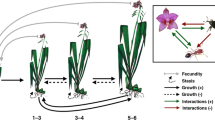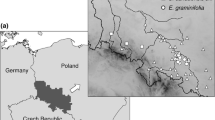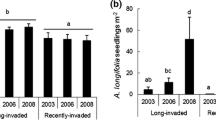Gleditsia triacanthos
and the native dominant Lithraea ternifolia in montane forests of central Argentina, considering life history and demographic traits of both the alien and the native species and different site conditions for population growth (good and bad sites). Matrix models are applied to project the consequences of differences in vital rates for population growth. Analyzing these models helps identify which life cycle transitions contributed most to population growth. Obtained population growth rates are considered to assess predicted rates of spread using the reaction-diffusion (R-D) model. G. triacanthos presents many of the life history traits that confer plants high potential for invasiveness: fast growth, clonal and sexual reproduction, short juvenile period, high seed production, and high seed germinability. These traits would ensure G. triacanthos invasive success and the displacement of the slow-growing, relatively less fecund native L. ternifolia. However, since disturbance and environmental heterogeneity complicate the invasibility pattern of G. triacanthos in these montane forests, the outcome of the invasion process is not straightforward as could be if only life history traits were considered.
Great variation in demographic parameters was observed between populations of each species at good and bad sites. Though both good and bad sites signified increasing or at least stable populations for G. triacanthos, for L. ternifolia bad sites represented local extinction. Analyzing the results of matrices models helps design the optimal management for the conservation of L. ternifolia populations while preventing the invasion by G. triacanthos. The predicted asymptotic rate of spread for G. triacanthos at the good site was fourfold greater than the predicted one for L. ternifolia, although the difference was much smaller considering the bad site. The usefulness of the R-D model to study this invasion system is discussed.
Similar content being viewed by others
Author information
Authors and Affiliations
Rights and permissions
About this article
Cite this article
Marco, D., Páez, S. Invasion of Gleditsia triacanthos in Lithraea ternifolia Montane Forests of Central Argentina. Environmental Management 26, 409–419 (2000). https://doi.org/10.1007/s002670010098
Issue Date:
DOI: https://doi.org/10.1007/s002670010098




